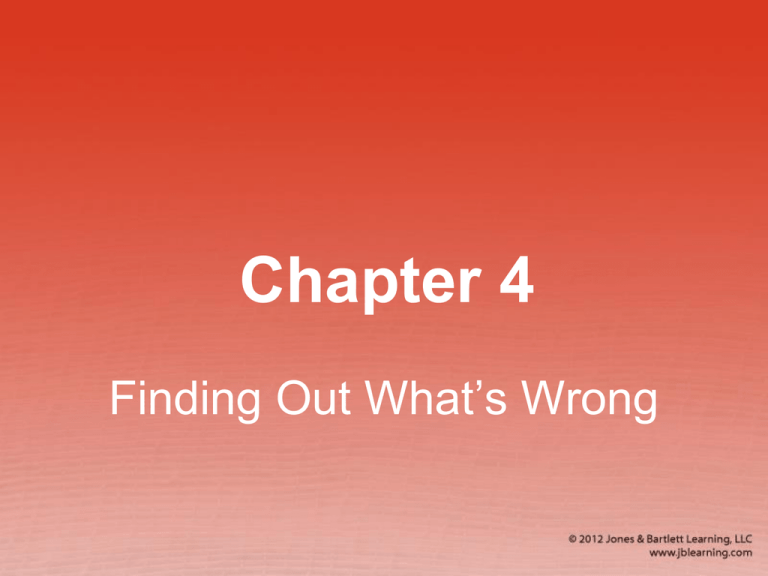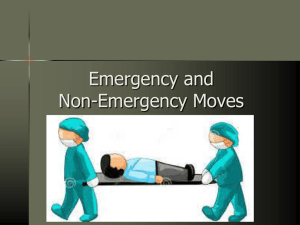Chapter 4 Power Point Slides
advertisement

Chapter 4 Finding Out What’s Wrong Victim Assessment Overview (1 of 2) • Knowing what to do and what not to do is crucial during an emergency. • A victim assessment is a sequence of actions that helps determine what is wrong. • A primary check will determine if: • there is illness or injury. • whether the victim is responsive or unresponsive. • if a life-threatening condition exists. Victim Assessment Overview (2 of 2) Assessment Steps • • • • • Scene size-up Primary check Secondary check SAMPLE history Reassessment Scene Size-Up • • • • Look for hazards. Notice the potential for violence. Be observant of weapons. Reduce exposure to potentially dangerous body substances. • Determine whether the problem is an injury or an illness . Primary Check (1 of 2) Identify life-threatening conditions so that you can immediately take action to treat the conditions. •Responsiveness •Circulation •Breathing •Severe bleeding Primary Check (2 of 2) Form a first impression. • • • • • • • Injury or illness? Responsive or unresponsive? Breathing adequately? Talking? Bleeding? Chance of exposure to blood or body fluids? Danger to you, victim, or bystanders? Check Responsiveness • Tap the victim on the shoulder and ask, “Are you okay?” • Use the AVPU scale. Alert Victim • Evaluate ability to remember. • • • • What is your name? Do you know where you are? What are the month and year? What happened? An Unresponsive Victim RAP-CAB (1 of 4) R = Responsive? Tap shoulder and shout, “Are you okay?” Courtesy of Berta A. Daniels, 2010 An Unresponsive Victim RAP-CAB (2 of 4) A = Activate emergency medical services (EMS) Courtesy of Berta A. Daniels, 2010 An Unresponsive Victim RAP-CAB (3 of 4) P = Position the victim on his or her back. C = Cardiopulmonary resuscitation (CPR) Start with 30 chest compressions if the victim is not breathing. Courtesy of Berta A. Daniels, 2010 An Unresponsive Victim RAP-CAB (4 of 4) A = Airway Open the airway. B = Breaths Give two breaths and continue CPR. Courtesy of Berta A. Daniels, 2010 A Responsive Victim RAP-ABC R = Responsiveness A = Activate EMS P = Position A = Airway B = Breathing C = Circulation Check for Breathing • Chest movement • Normal and abnormal breath sounds • Feeling adequate air movement Check for Severe Bleeding • Check for a large amount of blood. • Around the victim • On the victim’s clothing • Control bleeding. • Wear exam gloves. Position the Victim Most victims should not be moved. •Exceptions: • Unsafe location • Victim is face down and needs CPR. • Victim has difficulty breathing from vomit or secretions. • First aider is alone and must leave to get help. High Arm IN Endangered Spine (HAINES) (1 of 2) • Keep left arm straight, extended above the head with upper part of the arm next to the head. • Bring right arm across the chest. • Place back of right hand against the left cheek and hold it there. High Arm IN Endangered Spine (HAINES) (2 of 2) • Bend the far leg at the knee and pull the bent leg to roll the victim toward you. • Head stays on left arm while rolling. • Right hand stabilizes the head. • Right bent knee prevents rolling. Left Side Advantages • • • • Keeps the airway open Delays vomiting Delays a poison’s effect Relieves pressure on a pregnant woman’s vena cava Secondary Check (1 of 2) • Determine whether the cause or mechanism of injury was significant. • Assume a victim with a head injury also has a spinal injury. Secondary Check (2 of 2) • For a responsive victim: • Ask if he or she can feel or wiggle the fingers and toes. • For an unresponsive victim: • Check spinal cord with Babinski reflex test. Signs and Symptoms Signs • • • • See Feel Hear Smell Symptoms • Things the victim feels • Things the victim can describe • Chief complaint DOTS D = Deformity O = Open wounds T = Tenderness S = Swelling © Johnathan Noden-Wilkinson/ShutterStock, Inc. Significant Cause of Injury (1 of 5) • Check the head. • Check eyes (PERRL). • Check the ears. • Check the nose. • Check the mouth. Significant Cause of Injury (2 of 5) • Check the neck. • Check the chest. • Gently press inward. Significant Cause of Injury (3 of 5) • Check the abdomen. • Gently press on all four quadrants. Significant Cause of Injury (4 of 5) • Check pelvis. • Gently press downward on tops of hips. • Press downward. Significant Cause of Injury (5 of 5) • Check extremities. • Circulation • Sensation • Movement • Check back. Special Considerations (1 of 4) • Skin condition • Color • Temperature • Moisture Special Considerations (2 of 4) • Capillary refill test • Press fingernail or toenail for a few seconds and release. Special Considerations (3 of 4) • Expose injury. • Explain what you are doing. • Maintain privacy. • Prevent exposure to cold. Special Considerations (4 of 4) • Check the following for medical identification tags: Courtesy of the MedicAlert Foundation ® Courtesy of the MedicAlert Foundation ® • • • • Wallet Purse Necklace Bracelet SAMPLE History Recheck • Serious illness or injury: every 15 minutes • Unresponsive victim: at least every 5 minutes Triage Process of prioritizing multiple victims • • • • Immediate care Delayed care “Walking wounded” Dead








